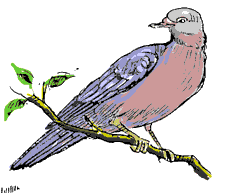
Dimdima
Online Children's Magazine from India

Dimdima
Online Children's Magazine from India
By Luis

IN 1860, the Passenger Pigeon or Migrating Dove was the most numerous of any bird species in the world. These pigeons accounted for 40% of the entire avian population of North America.
One nesting site in Kentucky was 64 km in length and several kilometres wide. The famous ornithologist and illustrator James Audubon saw the migration of these doves in 1813 and estimated that one flock contained 1,015,036,000 birds! He saw three such flocks. "The light of the noonday sun was obscured as by an eclipse," he wrote later. On a visit to their nesting site, he mistook the dung for snow, so deep was it on the forest floor. When the flocks returned at dusk, the sound of their landing was like thunder.
In fact, the great migrations accounted for their being able to find sufficient food, which consisted of acorns, nuts, seeds, grain, berries and insects. They were sturdy birds capable of flying 1600 km a day at a speed of 96 km an hour. They were long-lived as well, with an average life-span of 25 years.
It seems unbelievable that the passenger pigeon became extinct, when even in 1870, when hunting had reduced their numbers greatly, one could observe flocks of 2000 million birds.
But the demand for passenger pigeons in the 1860's was phenomenal and unrelenting. They were prized for their meat and their blood, entrails and even dung were marketed as cures for dysentery, epilepsy, fever and colic! The feathers and down were used for stuffing pillows and quilts. Trapshooters bought a million birds a year for target practice, one sportsman killing maybe 500 birds in a single day.
The invention of the telegraph and the railway spelt doom for the passenger pigeon. Hunters were able to follow and slaughter migrating birds and then transport the carcasses quickly. In 1878, 1000 million birds were slaughtered in Petoskey. Michigan.
Then in 1896 the one last great nesting flock of 250,000 passenger pigeons came together at a site near Mammoth Cave in Ohio. Hunters descended on them in droves. Only 5000 birds escaped the massacre. Not one dead bird reached the market as a derailment resulted in a shipping delay. More than 200,000 rotting carcasses were finally dumped in a deep ravine nearby.
The last passenger pigeon in the wild was shot in 1900. On September 1, 1914, in the Cincinnati Zoo, Martha, a passenger pigeon born in captivity died at the age of 29, the last of her species.
Last updated on :7/9/2003
EXPLORE MORE...
COMMENT ON THIS ARTICLE
Wants to share something related to this article? Please use the form below.
Dimdima is the Sanskrit word for ‘drumbeat’. In olden days, victory in battle was heralded by the beat of drums or any important news to be conveyed to the people used to be accompanied with drumbeats.
Bharatiya Vidya Bhavan
K. M Munshi Marg,
Chowpatty, Mumbai - 400 007
email : editor@dimdima.com
Bharatiya Vidya Bhavan
505, Sane Guruji Marg,
Tardeo, Mumbai - 400 034
email : promo@dimdima.com
Dimdima.com, the Children's Website of Bharatiya Vidya Bhavan launched in 2000 and came out with a Printed version of Dimdima Magazine in 2004. At present the Printed Version have more than 35,000 subscribers from India and Abroad.